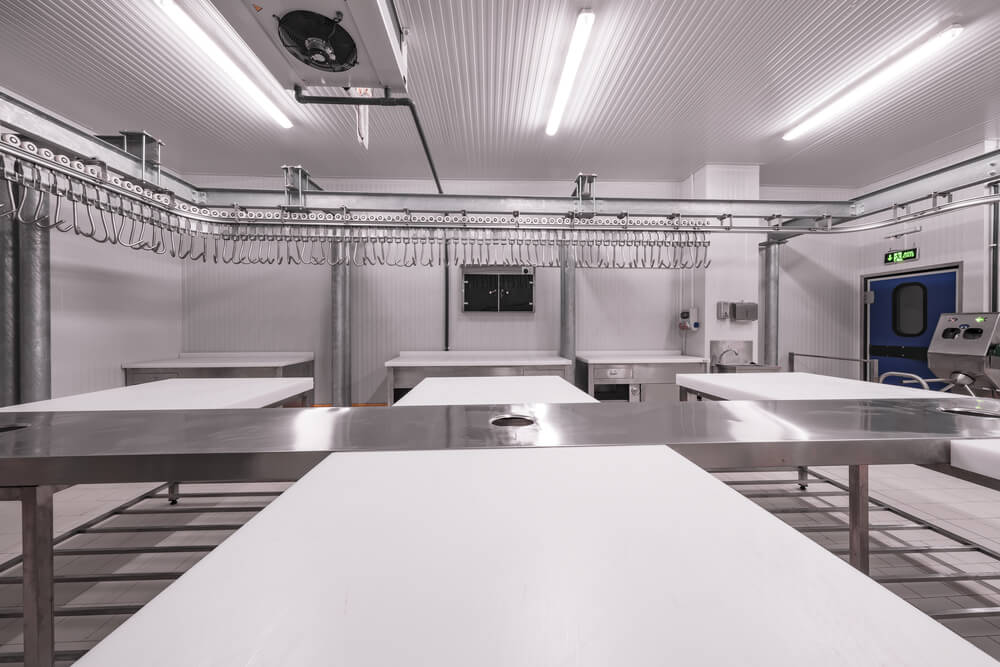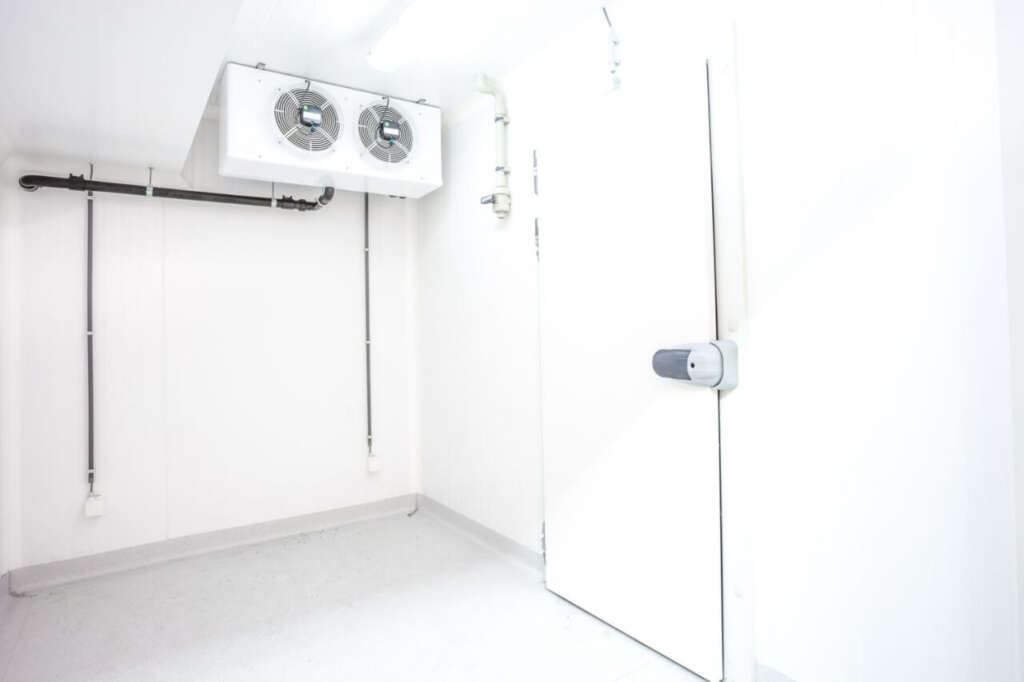Maintaining the correct temperature in commercial walk-in refrigerators is crucial for preserving food quality and safety. Proper temperature control helps prevent spoilage, inhibits bacterial growth, and ensures that perishable items remain fresh for longer periods. With the fast-paced nature of the food industry, adhering to strict temperature guidelines is not just a best practice; it’s a necessity to comply with health regulations and avoid costly waste. In this guide, we will explore the temperature guidelines for commercial walk in refrigerators.
Understanding Temperature Ranges for Commercial Refrigeration in Kitchens
The primary purpose of a refrigerator in commercial kitchens is to maintain a cooler temperature for various food items, effectively slowing down bacterial growth and keeping consumable foods safe. In contrast, a freezer is designed to halt bacterial growth altogether. Typically, the operating temperature range for commercial refrigeration units is between 2°C and 6°C. Storing food items below 2°C can risk freezing products that should remain chilled, such as milk and dairy items, while temperatures above 6°C can lead to spoilage.
Certain food items are more sensitive to temperature fluctuations than others, so it’s important to consider both the type of food being stored and the refrigeration unit in use, as these factors will influence the necessary temperature settings. For example, any food requiring storage below 2°C will need a forced defrost cycle. Additionally, commercial refrigeration units take time to stabilize at their set temperatures; larger units generally require longer periods to cool down products effectively. Therefore, when adjusting the temperature, allow a full day for the unit to stabilize before placing food items inside the refrigerator.
If you are looking for a Commercial Walk in Refrigerators installer in Los Angeles, Kitchen Services offer comprehensive installation service, from helping you select the right model to install it with a focus on quality. Our experienced refrigeration technicians have been installing commercial refrigeration equipment for a very long time.
Ways to maintain the temperature once it’s stabilized.
Keep in mind that these commercial refrigeration temperatures keep on rising the most if the door of the refrigerator is open. As the refrigerator’s thermostat is usually located near the doors, this can cause a false read some of the time. In case you notice that the temperature is reading above normal then try to wait for about 10 minutes with the door closed and then check the temperature again.
It is also very crucial and important to keep in mind that in case your refrigerator temperatures fall below 36° Fahrenheit it may cause freezing of certain foods which results in poor quality in taste, texture as well as appearance. Meanwhile, anything above 40° F will promote the growth of microorganisms. This makes 38° F an ideal temperature for safely storing perishables.
Call For Walk in Commercial Refrigerator Installation
Ideal Refrigeration Temperature: 38° F
As all the commercial refrigeration units range broadly in their size and configurations as well as items that are being stored in any of these refrigerators, it can be very critical to know if the temperature is steady throughout the whole unit. Many of the commercial refrigerators or freezers come with a thermometer, but as stated earlier they are normally located very close to the refrigerator’s door. This obviously means that the temperature readings can vary considerably during high usage times. This eventually may lead to a poor understanding of your refrigeration’s operating performance. It is very important to monitor it closely and take all of these factors into consideration for the best results.
Recommended Food-Safety Best Practice
In order to keep your food safe and protected, the best practice would be consistently checking and recording the temperatures regularly throughout the whole day. This step can also be done manually with a temperature log chart or any spreadsheet. Many companies nowadays offer automated refrigerator monitoring solutions that help in notifying you of prolonged door openings or extreme temperature fluctuations by SMS alerts or even by emails they can also track your refrigerator’s temperatures throughout the day it also saves you time, energy costs, and potential product loss as well.
What is the temperature range for Walk in Fridge?

Eventually, the temperature of your refrigerator will be dependent on the products that you are storing in it, but in most cases, the ideal scenario would be that it should be between 35 to 45 degrees Fahrenheit. As the freezing point of water is around 32°F, so you would never want the temperature to drop to that point. Consequently, the question may arise, what temp should a commercial fridge be? The United States Food and Drug Administration (FDA) states that refrigerated products must be kept at 41 Degrees Fahrenheit or even at lower temperatures than this but as we know that the colder the food is the more it will last, making 38F a perfect temperature for commercial refrigeration. Freezer temperature ranges are usually much colder. You must keep the refrigerator temperature at or below 40° F (4° C). The freezer temperature should be 0° F (-18° C). you will need to check temperatures regularly. Appliance thermometers are the best way of knowing these temperatures and are generally inexpensive.
Temperature Monitoring for Commercial Walk in refrigerators
The RDT Eco-Smart is an electronically operated evaporator controller that is designed in such a way that they help in saving energy in your commercial freezers. In case they are connected to the internet, operators can view temperature logs from their phone, tablet as well as on computers. You would never have to wake up in a cold sweat in the middle of the night worried about your refrigerators. You can now monitor the freezer temperatures right in bed. And when the Eco-Smart is alerted to something wrong with your freezer, you will be too.
Tips for proper Food Storage

Once your Commercial Walk in Refrigerators have been set to the ideal temperature, it will become very important that you know exactly how to freeze foods prudently. In order to store food, you will have to achieve the following:
- Avoid moisture loss
- Thwart freezer burn
- Prevent the transfer of scents between foods
- Avoid food poisoning as the food cools
- You should always wrap meats and other baked products tightly in any foil before you put them into freezer bags.
- You must remove as much air as you can from freezer bags before you seal them
- If using freezer-safe containers, make sure they closely fit the amount of food being frozen
Once your food items are in the freezer, you must stay within the storage timeframes. As per government guidelines that are stated in many clauses, beef has the ability to maintain its quality in the freezer for about 10 to 12 months. But ground meat can stay fresh for only 2 to 3 months. Lean fish like cod and flounder can stay in the freezer for about 6 months. In the meantime, frozen bacon stays fresh just for a month and no more. You should always make sure that your staff is well aware of all these guidelines by significantly displaying signs at your food storage area. Proper food processing should always be the top main concern among all of your employees. You must never forget that commercial freezers can go through some little temperature variations each time you leave the doors of your refrigerators open for a longer period of time. You should always remind all of your staff members and employees to always keep the doors shut in order to avoid cold air leaking out of your unit. Many of the models nowadays include freezer doors that automatically lock when the temperature becomes less than ideal.
How to Organize a Commercial Freezer
Advantages of properly Frozen Foods
No matter what you own, whether it is a restaurant, you own a butcher shop, or a convenience store, your business can take advantage of foods that are appropriately frozen. In this way, you will be able to ensure that your clients are getting high-quality food products without having any concern that they may fall victim to food poisoning through your food. Your business will also be able to decrease food waste. And if you own a commercial freezer that is an energy-efficient model, the cost savings will be even more than you may ever think. Think about investing in a high-quality refrigeration system and you can relax the whole time you are using that device without having to worry about any shortcomings. A good machine will always have temperature controls that would allow you to maintain perfect temperatures for the whole year.
Optimizing Temperature Control in Walk-In Coolers and Freezers
When considering the ideal refrigerator temperature, maintaining proper temperature control is essential for ensuring food safety and freshness in any refrigeration solution. For walk-in coolers and freezers, the fridge temperature should generally be set between 1°C and 4°C (34°F to 40°F), while the freezer temperature should be at or below -18°C (0°F). The efficiency of the unit is influenced by various factors, including the interior space and the materials used in construction, such as galvanized steel for durability. For those considering outdoor installation, ensuring proper insulation and climate control is crucial to maintaining the correct temperature despite external fluctuations.
Custom walk-in units can be designed to optimize the energy efficiency of the refrigeration units, allowing for better management of temperature settings. Ultimately, whether you’re using a fridge or freezer, it’s important to monitor and adjust these conditions regularly to ensure that your food items remain safe and fresh.
Common FAQs about Walk in Commercial Refrigerator
What is the standard temperature of walk in chiller?
The standard walk in chiller temperature is 35-38°F. For walk-in coolers, it’s best practice to set the temperature in the 35-38°F range. However, be careful to not let the temperature get too cold. If the temperature drops below 34°F, products might begin to freeze.
What is the temperature for meat storage?
The ideal temperature for the storage of fresh meat is 28°F to 32°F. Meat should be stored in the coldest part of the refrigerator. As storage temperatures approach 40°F perishability increases. Rapid growth of bacteria begins at about 50°F.
What is the average refrigerator temperature?
The average refrigerator temperature is typically set between 1°C and 4°C (34°F to 40°F). This range helps keep food fresh while slowing bacterial growth. For optimal food safety, it’s recommended to keep the temperature at or below 4°C (40°F). Regularly checking the temperature with an appliance thermometer can ensure that your refrigerator is maintaining the proper conditions for food storage.

